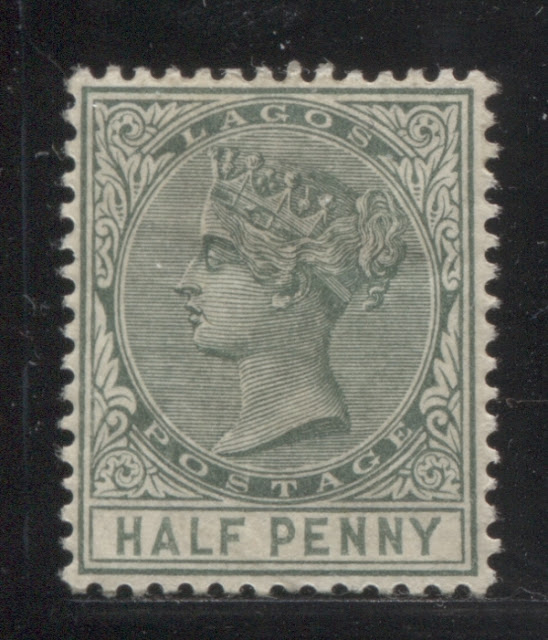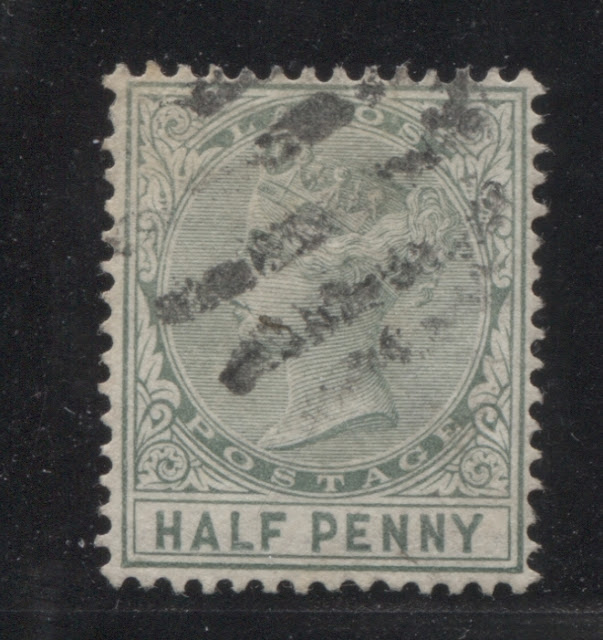Printings of the 1/2d Green and 1d Carmine Queen Victoria Keyplate Stamps of Lagos 1887-1904 Part Two
Today's post will launch right into an examination of the printings of the 1/2d green and 1d carmine Queen Victoria keyplate stamps that were made from the first state of the plate. By my reckoning in last week's post, it was my opinion that each of these denominations should have had approximately 12 printings each, made between March 1887 and either December 1889 or January 1890.
So the starting point in identifying these is to look through my many mint and used examples for stamps that were clearly printed from the first state of the plate. As stated in all my previous posts, the first state of the plate is characterized by the almost complete lack of wear in the design, and by the following characteristics:
The head and duty plate colours of this printing are also the same. The green is a dull green that is deeper than Gibbons's dull green, and with a bluish undertone as well. It is however, not as blue as Gibbons' dull blue green. So I would call this the deep dull bluish green.
Eleventh Printing
The head plate colour of this printing is closest to myrtle green, but duller. The duty plate is a pale dull blue green. So I would call this dull myrtle green and pale dull blue green. This is the printing that I have the largest number of examples of, with seven mint stamps, and none of them used.
Twelfth Printing
The head plate of this printing is a very close match to Gibbons's deep dull green, but this colour is distinctly bluish, but not quite bluish enough to be myrtle green. The duty plate colour is the same overall tone, but is paler. So to me this printing is deep dull bluish green and dull bluish green.
This is another printing for which I have a large number of mint examples, with five stamps and one used example. The used stamp on the right is cancelled with what appears to be a 9-bar oval obliterator, based on the narrow width of the bars.
Sixteenth Printing
The head and duty plate colour of this printing is very similar to the deep dull blue green of the sixteenth printing above, but with this colour being a little brighter.
I have the three mint examples shown above, but also a nice upper right corner block of 4, with "current number 1", which confirms that this printing was made before current numbers were abandoned in 1891. This block is shown below:
Eighteenth Printing
Nineteenth Printing

So the starting point in identifying these is to look through my many mint and used examples for stamps that were clearly printed from the first state of the plate. As stated in all my previous posts, the first state of the plate is characterized by the almost complete lack of wear in the design, and by the following characteristics:
- Generally speaking, the horizontal shading lines in the background of the portrait medallion, will all be clearly separated from the other lines, and will be more or less the same thickness, from the top of the medallion, to the bottom.
- All of the hairlines in the hair above the crown will be clearly visible as separate lines. There will be no merging of these lines, whatsoever.
- There will be clear detail in the hair at the back of the head, where the hair meets the neck. Here, there is what resembles a bun, with a diagonal ribbon separating the bun into two sections. There should be clear lines present demarcating the hair, both above, and below the ribbon.
- The detail in the jewels of the crown are all clear and distinct. There is no merging of any of the horizontal shading lines in the band of the crown.
As stated in my previous post, there should have been very few late usages, if any at all. So for the used stamps, we should see cancellations that are consistent with those commonly in use during this period. For this period, the most common cancellation would be the 8-bar or 9-bar oval obliterator, followed, to a much lesser extent by the 21 mm Lagos CDS. The larger 24 mm CDS did not come into use until the late 1890's, so we should not see this cancellation of the used stamps of this period.
Today's post will look at the halfpenny stamps, and next week, I will look at the 1d stamps.
Group 1: Printings 7-19 From The First State of the Plate - March 1887 to December 1889/January 1890
Seventh Printing
The head plate of this printing is closest to deep dull green on the Gibbons colour key, while the duty plate colour is the same tone, but in a slightly paler shade.
Eighth Printing
The head plate colour of this printing is a very close match to Gibbons's deep green. The duty plate is the same tone, but a slightly paler shade, though it is still deeper than regular green. I have two mint examples only, but both have no gum, and may have come from one of the shipments that was stuck together at sea, requiring the stamps to be soaked apart.
Ninth Printing
The head and duty plate of this printing are both the same colour. It is a dull green that is deeper than the Gibbons dull green, being about mid-way between the deep dull green and the dull green. Like the two mint stamps above, this one is also without gum.
Tenth Printing
The head and duty plate colours of this printing are also the same. The green is a dull green that is deeper than Gibbons's dull green, and with a bluish undertone as well. It is however, not as blue as Gibbons' dull blue green. So I would call this the deep dull bluish green.
Eleventh Printing
The head plate colour of this printing is closest to myrtle green, but duller. The duty plate is a pale dull blue green. So I would call this dull myrtle green and pale dull blue green. This is the printing that I have the largest number of examples of, with seven mint stamps, and none of them used.
Twelfth Printing
The head plate colour of this printing is very similar to the seventh printing, being very close to Gibbons's deep dull green. However this colour has a bluish undertone, but not bluish enough to be the myrtle green. The duty plate colour is the same as the head plate, but is a bit lighter.
Thirteenth Printing
The head and duty plate colour of this printing is closest to myrtle green, but is a touch lighter.
Fourteen Printing
The head plate and duty plate colours of this printing are the same and are closest to Gibbons's myrtle green, but the shade is dull by comparison to the Gibbons swatch. So I would call this the dull myrtle green.
Fifteenth Printing
The head plate of this printing is a very close match to Gibbons's deep dull green, but this colour is distinctly bluish, but not quite bluish enough to be myrtle green. The duty plate colour is the same overall tone, but is paler. So to me this printing is deep dull bluish green and dull bluish green.
This is another printing for which I have a large number of mint examples, with five stamps and one used example. The used stamp on the right is cancelled with what appears to be a 9-bar oval obliterator, based on the narrow width of the bars.
Sixteenth Printing
The head plate and duty plate colour of this printing are closest to Gibbons' dull blue green, but deeper. So I would call this the deep dull blue green.
Seventeenth Printing
The head and duty plate colour of this printing is very similar to the deep dull blue green of the sixteenth printing above, but with this colour being a little brighter.
I have the three mint examples shown above, but also a nice upper right corner block of 4, with "current number 1", which confirms that this printing was made before current numbers were abandoned in 1891. This block is shown below:
Eighteenth Printing
The head plate and duty plate are closest in tone to Gibbons's myrtle green, but the shade is much, much paler than the Gibbons swatch. I would therefore call this very pale myrtle green.
Nineteenth Printing

The head plate and duty plate colour of this printing are both the same, and are closest to Gibbons' grey green, with the colour being just a touch paler.
This concludes my review of the printings made from the first state of the plate. In all, I identified 13 printings, rather than the 12 that I was expecting to find. Of course, it is possible that one or two of these are actually one of the first six printings from 1885-1886 as well. But for the moment, I am comfortable classifying them as the first printings of the 1887-1889/1890 period.
Next week I will look at the printings of the 1d carmine made in the same period.















Comments
Post a Comment